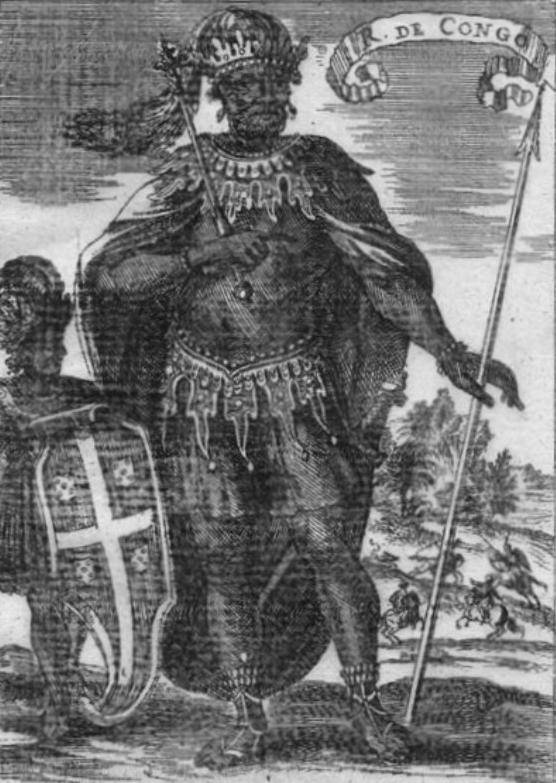
Angolan History: Bantu Kingdoms

Figure 1.--There are no Angolan images of the Bantu people that pre-date the arrival of the Portuguese. This drawing, dated 1685, shows the Mani-Kongo with his esquire. Here the artist engraved the scene using European models and some fantasy. In
reality probably the king would have been bare-chested and the boy basically, but with some adornment.
|
|
Small groups of Bantu tribesmen began migrating south into Angola (800-1000 AD). Historians differ somewhat on the chronology, but the Bantu migration increased markedly (14th century AD). It is at this time that theuy clearly are the dominant ethnic group (the 14th century or earlier). The Bantu were a more culturally advanced people with iron age technology. They soon became the dominant group. The absorbed or drove out much of the Khoisan-speaking peoples.
The population has been estimared at about 4 million people at the time the Portuguese arrived (15th century). Indigenous states were developing in southern Africa before the arrival of the Europeans. The most important in the area that is now Angola was the Kongo, Loango, Ndongo (Mbundo people), with smaller kingdoms such as the Lunda and Ovimbundu. The most important state in Central Africa was the Kongo Kihgdom, They were centered along the Altantic coast the area between central and southern Africa. The Kongo Kingdom were the most important of a series of states that arose along the Atlantic coast known as the Middle Atlantic kingdoms. Northern Angola was only part of the Kongo domains. The territirial expanse varied over time. The other kindoms were for the most part subject states paying tribute to the Kongo, but whose territory was more centered in Angloa. The country's name is derives its name from the Bantu kingdom of Ndongo. The word for king was ngola. These kingdoms did not have borders mirroring Angola's modern borders, but rather encompased area to the north in the Congo basin, but included parts of what is now Angola--primarily norther Angola. The leader of the important Kongo kingdom, mani-kongo (King Nzinga Nkuwu) converted to Christianity during the early Portuguese period. His successor, King Afonso, was also a Christian. The early relationship proved beneficial to both the Kongo and The Portuguese who traded with each other. They also had a similar social structure. The Portuguese did not move inland and threaten the Kongo and relied on trade with the Kongo and African kingdoms to provision its ships passing along the Angolan coast, This relationship began to deteriorate, however, as the slave trade became an increasingly important part of the Portuguese colonial economy. The Bantu kingdoms overlapped the Portuguese era and lasted nominally into the early-20th century. The Portuguese, however, broke the power of the African kindoms in a war with the Ndongo (17th century).
HBC

Navigate the Boys' Historical Clothing Web Site:
[Return to the Main Angolan history page]
[Return to the Main African history page]
[Introduction]
[Activities]
[Biographies]
[Chronology]
[Cloth and textiles]
[Clothing styles]
[Countries]
[Topics]
[Bibliographies]
[Contributions]
[FAQs]
[Glossaries]
[Images]
[Links]
[Registration]
[Tools]
[Boys' Clothing Home]
Navigate the Boys' Historical Clothing national pages:
[Return to the Main Angolan page]
[Return to the Main African page]
[Cape Verde Islands]
[Democratic Republic of the Congo]
[Gabon]
[Lessotho]
[Madagascar]
[Mali]
]South Africa]
[Uganda]
[Portugal]
Created: 10:35 AM 10/6/2010
Last updated: 5:48 PM 3/6/2013



